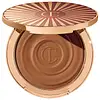What's inside
What's inside
 Key Ingredients
Key Ingredients

 Benefits
Benefits

 Concerns
Concerns

 Ingredients Side-by-side
Ingredients Side-by-side

Synthetic Fluorphlogopite
Talc
AbrasiveCalcium Aluminum Borosilicate
Dimethicone
EmollientDiisostearyl Malate
EmollientMica
Cosmetic ColorantLauroyl Lysine
Skin ConditioningTrimethylolpropane Triethylhexanoate
EmollientMethyl Methacrylate Crosspolymer
Silica
AbrasiveBis-Behenyl/Isostearyl/Phytosteryl Dimer Dilinoleyl Dimer Dilinoleate
EmollientSorbitan Sesquiisostearate
EmulsifyingSodium Dehydroacetate
PreservativeKaolin
AbrasiveTocopherol
AntioxidantChlorphenesin
AntimicrobialPotassium Hydroxide
BufferingLauryl Acrylate Crosspolymer
Iron Oxides
Synthetic Fluorphlogopite, Talc, Calcium Aluminum Borosilicate, Dimethicone, Diisostearyl Malate, Mica, Lauroyl Lysine, Trimethylolpropane Triethylhexanoate, Methyl Methacrylate Crosspolymer, Silica, Bis-Behenyl/Isostearyl/Phytosteryl Dimer Dilinoleyl Dimer Dilinoleate, Sorbitan Sesquiisostearate, Sodium Dehydroacetate, Kaolin, Tocopherol, Chlorphenesin, Potassium Hydroxide, Lauryl Acrylate Crosspolymer, Iron Oxides
Dimethicone
EmollientTriethylhexanoin
MaskingCeresin
Emulsion StabilisingPolymethylsilsesquioxane
Dimethicone Crosspolymer
Emulsion StabilisingTrimethylsiloxysilicate
EmollientPolyethylene
AbrasiveDimethicone/Polyglycerin-3 Crosspolymer
CleansingSilica
AbrasiveMica
Cosmetic Colorant7-Dehydrocholesterol
Emulsion StabilisingC10-18 Triglycerides
EmollientSodium Hyaluronate
HumectantTriolein
Skin ConditioningGlyceryl Dioleate
EmollientDipropylene Glycol
HumectantSodium Citrate
BufferingTocopherol
AntioxidantCI 77891
Cosmetic ColorantIron Oxides
Dimethicone, Triethylhexanoin, Ceresin, Polymethylsilsesquioxane, Dimethicone Crosspolymer, Trimethylsiloxysilicate, Polyethylene, Dimethicone/Polyglycerin-3 Crosspolymer, Silica, Mica, 7-Dehydrocholesterol, C10-18 Triglycerides, Sodium Hyaluronate, Triolein, Glyceryl Dioleate, Dipropylene Glycol, Sodium Citrate, Tocopherol, CI 77891, Iron Oxides
Ingredients Explained
These ingredients are found in both products.
Ingredients higher up in an ingredient list are typically present in a larger amount.
Dimethicone is a type of synthetic silicone created from natural materials such as quartz.
What it does:
Dimethicone comes in different viscosities:
Depending on the viscosity, dimethicone has different properties.
Ingredients lists don't always show which type is used, so we recommend reaching out to the brand if you have questions about the viscosity.
This ingredient is unlikely to cause irritation because it does not get absorbed into skin. However, people with silicone allergies should be careful about using this ingredient.
Note: Dimethicone may contribute to pilling. This is because it is not oil or water soluble, so pilling may occur when layered with products. When mixed with heavy oils in a formula, the outcome is also quite greasy.
Learn more about DimethiconeMica is a naturally occurring mineral used to add shimmer and color in cosmetics. It can also help improve the texture of a product or give it an opaque, white/silver color.
Serecite is the name for very fine but ragged grains of mica.
This ingredient is often coated with metal oxides like titanium dioxide. Trace amounts of heavy metals may be found in mica, but these metals are not harmful in our personal products.
Mica has been used since prehistoric times throughout the world. Ancient Egyptian, Indian, Greek, Roman, Aztec, and Chinese civilizations have used mica.
Learn more about MicaSilica, also known as silicon dioxide, is a naturally occurring mineral. It is used as a fine, spherical, and porous powder in cosmetics.
Though it has exfoliant properties, the function of silica varies depending on the product.
The unique structure of silica enhances the spreadability and adds smoothness, making it a great texture enhancer.
It is also used as an active carrier, emulsifier, and mattifier due to its ability to absorb excess oil.
In some products, tiny microneedles called spicules are made from silica or hydrolyzed sponge. When you rub them in, they lightly polish away dead skin layers and enhance the penetration of active ingredients.
Learn more about SilicaTocopherol (also known as Vitamin E) is a common antioxidant used to help protect the skin from free-radicals and strengthen the skin barrier. It's also fat soluble - this means our skin is great at absorbing it.
Vitamin E also helps keep your natural skin lipids healthy. Your lipid skin barrier naturally consists of lipids, ceramides, and fatty acids. Vitamin E offers extra protection for your skin’s lipid barrier, keeping your skin healthy and nourished.
Another benefit is a bit of UV protection. Vitamin E helps reduce the damage caused by UVB rays. (It should not replace your sunscreen). Combining it with Vitamin C can decrease sunburned cells and hyperpigmentation after UV exposure.
You might have noticed Vitamin E + C often paired together. This is because it is great at stabilizing Vitamin C. Using the two together helps increase the effectiveness of both ingredients.
There are often claims that Vitamin E can reduce/prevent scarring, but these claims haven't been confirmed by scientific research.
Learn more about TocopherolThis ingredient is a combination of red, black, and yellow iron oxide pigments. This combination of colors is usually found in foundation, because it results in a "skin" color.